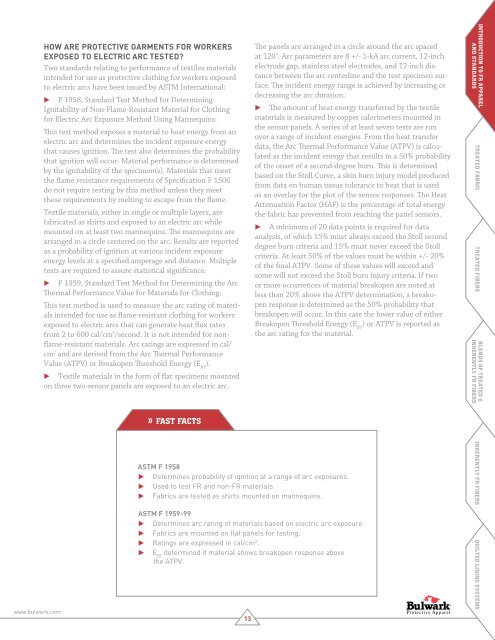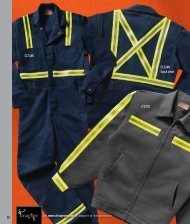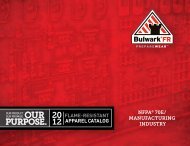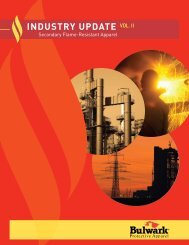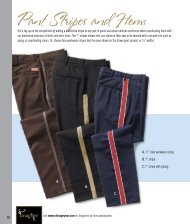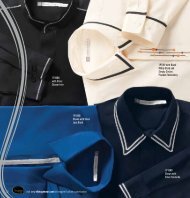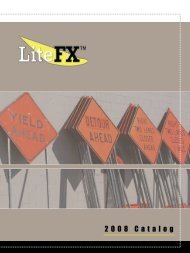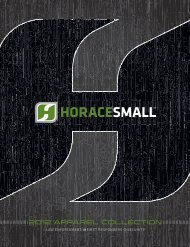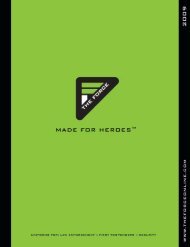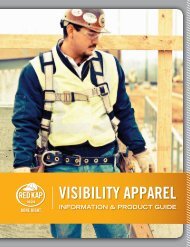VOL. 10 - Red Kap Work Clothes, Uniforms, & Coveralls
VOL. 10 - Red Kap Work Clothes, Uniforms, & Coveralls
VOL. 10 - Red Kap Work Clothes, Uniforms, & Coveralls
Create successful ePaper yourself
Turn your PDF publications into a flip-book with our unique Google optimized e-Paper software.
How are protective garments for workers<br />
exposed to electric arc tested?<br />
Two standards relating to performance of textiles materials<br />
intended for use as protective clothing for workers exposed<br />
to electric arcs have been issued by ASTM International:<br />
u F 1958, Standard Test Method for Determining<br />
Ignitability of Non-Flame-Resistant Material for Clothing<br />
for Electric Arc Exposure Method Using Mannequins:<br />
This test method exposes a material to heat energy from an<br />
electric arc and determines the incident exposure energy<br />
that causes ignition. The test also determines the probability<br />
that ignition will occur. Material performance is determined<br />
by the ignitability of the specimen(s). Materials that meet<br />
the flame resistance requirements of Specification F 1506<br />
do not require testing by this method unless they meet<br />
these requirements by melting to escape from the flame.<br />
Textile materials, either in single or multiple layers, are<br />
fabricated as shirts and exposed to an electric arc while<br />
mounted on at least two mannequins. The mannequins are<br />
arranged in a circle centered on the arc. Results are reported<br />
as a probability of ignition at various incident exposure<br />
energy levels at a specified amperage and distance. Multiple<br />
tests are required to assure statistical significance.<br />
u F 1959, Standard Test Method for Determining the Arc<br />
Thermal Performance Value for Materials for Clothing:<br />
This test method is used to measure the arc rating of materials<br />
intended for use as flame-resistant clothing for workers<br />
exposed to electric arcs that can generate heat flux rates<br />
from 2 to 600 cal/cm 2 /second. It is not intended for nonflame-resistant<br />
materials. Arc ratings are expressed in cal/<br />
cm 2 and are derived from the Arc Thermal Performance<br />
Value (ATPV) or Breakopen Threshold Energy (E BT<br />
).<br />
u Textile materials in the form of flat specimens mounted<br />
on three two-sensor panels are exposed to an electric arc.<br />
The panels are arranged in a circle around the arc spaced<br />
at 120°. Arc parameters are 8 +/- 1-kA arc current, 12-inch<br />
electrode gap, stainless steel electrodes, and 12-inch distance<br />
between the arc centerline and the test specimen surface.<br />
The incident energy range is achieved by increasing or<br />
decreasing the arc duration.<br />
u The amount of heat energy transferred by the textile<br />
materials is measured by copper calorimeters mounted in<br />
the sensor panels. A series of at least seven tests are run<br />
over a range of incident energies. From the heat transfer<br />
data, the Arc Thermal Performance Value (ATPV) is calculated<br />
as the incident energy that results in a 50% probability<br />
of the onset of a second-degree burn. This is determined<br />
based on the Stoll Curve, a skin burn injury model produced<br />
from data on human tissue tolerance to heat that is used<br />
as an overlay for the plot of the sensor responses. The Heat<br />
Attenuation Factor (HAF) is the percentage of total energy<br />
the fabric has prevented from reaching the panel sensors.<br />
u A minimum of 20 data points is required for data<br />
analysis, of which 15% must always exceed the Stoll second<br />
degree burn criteria and 15% must never exceed the Stoll<br />
criteria. At least 50% of the values must be within +/- 20%<br />
of the final ATPV. Some of these values will exceed and<br />
some will not exceed the Stoll burn injury criteria. If two<br />
or more occurrences of material breakopen are noted at<br />
less than 20% above the ATPV determination, a breakopen<br />
response is determined as the 50% probability that<br />
breakopen will occur. In this case the lower value of either<br />
Breakopen Threshold Energy (E BT<br />
) or ATPV is reported as<br />
the arc rating for the material.<br />
introduction to fr apparel<br />
and standards<br />
treated fabric<br />
treated fibers<br />
BLENDS OF TREATED &<br />
INHERENTLY FR FIBERS<br />
» FAST FACTS<br />
ASTM F 1958<br />
u Determines probability of ignition at a range of arc exposures.<br />
u Used to test FR and non-FR materials.<br />
u Fabrics are tested as shirts mounted on mannequins.<br />
INHERENTLY FR FIBERS<br />
www.bulwark.com<br />
ASTM F 1959-99<br />
u Determines arc rating of materials based on electric arc exposure.<br />
u Fabrics are mounted on flat panels for testing.<br />
u Ratings are expressed in cal/cm 2 .<br />
u E BT<br />
determined if material shows breakopen response above<br />
the ATPV.<br />
13<br />
quilted lining systems


